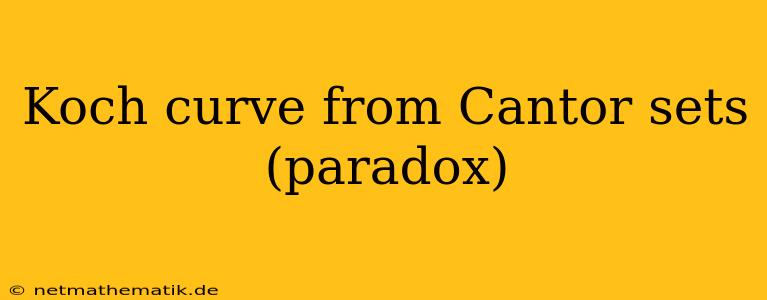The Koch curve, a fascinating fractal, stands as a testament to the power of self-similarity and the boundless complexity that can arise from simple iterations. Its construction, involving repeated division and replacement of line segments, leads to a curve with infinite length yet finite area, a paradox that echoes the intricacies of the Cantor set. This exploration delves into the intriguing connection between the Koch curve and the Cantor set, unraveling the mathematical underpinnings of this paradoxical relationship.
The Koch Curve: A Journey into Infinite Length
The Koch curve, named after the Swedish mathematician Helge von Koch, is a classic example of a fractal. Its construction is deceptively simple, yet it yields a curve with profound and paradoxical properties. Starting with a line segment, the Koch curve is generated through an iterative process where each segment is divided into three equal parts, and the middle part is replaced with two segments of equal length, forming an equilateral triangle pointing outward. This process is then repeated infinitely for each newly created segment.
Self-Similarity and Fractal Dimension
The Koch curve exhibits self-similarity, a hallmark of fractals. This means that any portion of the curve, no matter how small, is identical to the entire curve when scaled appropriately. This self-similarity is evident at every level of magnification, revealing an intricate structure that repeats infinitely. This property, combined with its infinite length, gives the Koch curve a fractal dimension greater than one but less than two, reflecting its non-Euclidean nature.
The Cantor Set: A Journey into Dust
The Cantor set, another remarkable creation of mathematics, provides a crucial link to understanding the paradoxical properties of the Koch curve. The Cantor set is constructed by repeatedly removing the middle third of each segment in a line. This process, applied infinitely, results in a set of points scattered along the line, resembling dust.
Fractal Dimension and the Koch Curve Connection
Like the Koch curve, the Cantor set also displays self-similarity and has a fractal dimension. Its dimension, however, is less than one, signifying its fragmented and dust-like nature. Despite its seemingly simple construction, the Cantor set possesses infinite points and a measure of zero, further highlighting the paradoxical nature of fractals.
Unraveling the Paradox: Connecting the Koch Curve and the Cantor Set
The connection between the Koch curve and the Cantor set lies in their shared construction process and their manifestation of paradoxical properties. The Cantor set serves as a foundation for understanding the infinite length of the Koch curve.
The Infinite Length Paradox
Imagine constructing the Koch curve by iteratively replacing line segments with the three-segment pattern. As each iteration progresses, the total length of the curve increases. This increase is multiplicative, meaning the length grows exponentially with each step. At the limit, as the iterations approach infinity, the length of the Koch curve also approaches infinity.
The Finite Area Paradox
Despite its infinite length, the Koch curve encloses a finite area. This seeming paradox arises from the fact that the area enclosed by the curve increases at a slower rate than the length. This can be visualized by noting that the area added at each iteration is smaller than the previous iteration. As the number of iterations approaches infinity, the area enclosed approaches a finite limit, while the length approaches infinity.
Conclusion: The Koch Curve and the Cantor Set – A Mathematical Paradox
The Koch curve and the Cantor set stand as remarkable examples of mathematical objects that defy our intuitive understanding of space and dimension. The self-similarity and fractal dimension of these constructs challenge our traditional Euclidean concepts, leading to paradoxical properties like infinite length with finite area. The connection between these two fractals highlights the power of iterative processes and the fascinating complexity that arises from simple, yet infinite, repetition. These mathematical wonders continue to inspire exploration and discovery, pushing the boundaries of our comprehension and revealing the boundless beauty and enigma of the mathematical universe.
